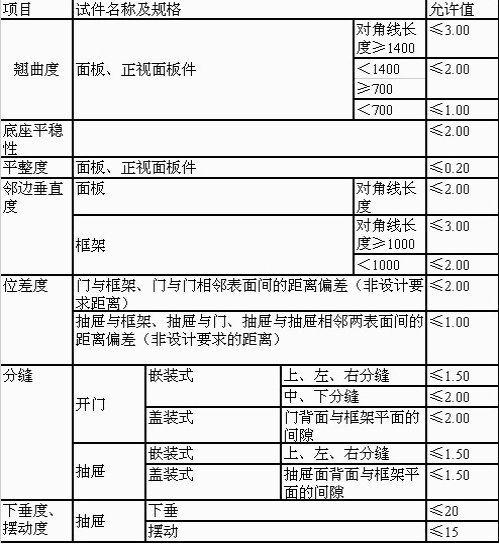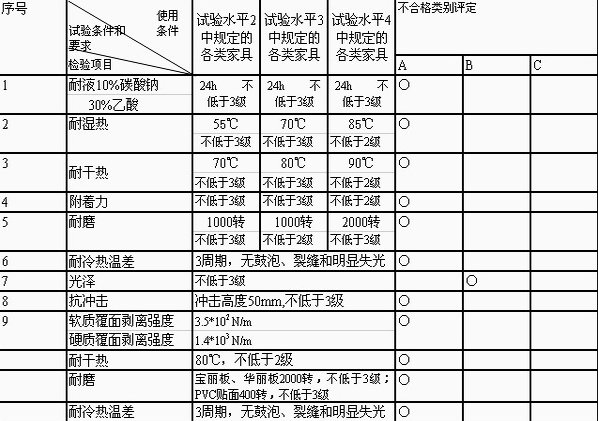Standard code: GB/T3324-2008 Chinese name: General technical conditions for wood furniture Implementation time: May 1, 2009 Main contents: This standard specifies the terms and definitions of wood furniture, product classification, requirements, test methods, inspection rules and signs, instructions for use, packaging, transportation, storage, etc. Applicable product categories: wooden pieces for wood furniture and other furniture. Mandatory/Basic Requirements: Chapter 4 of this standard specifies the technical requirements of the product, including major dimensional and dimensional tolerances, shape and position tolerances, material requirements, woodworking requirements, finishing requirements, physical and chemical performance requirements, and mechanical properties. 4 Technical requirements 4.1 Main dimensions and dimensional tolerances 4.1.1 The main dimensions of tables, chairs and stools shall comply with the provisions of GB 3326. 4.1.2 The main dimensions of cabinets shall comply with the provisions of GB 3327. 4.1.3 The main dimensions of the bed should comply with the provisions of GB 3328. 4.1.4 The limit deviation of the product's wide, deep and high dimensions is ±5MM, and the limit deviation of the matching or combination product should be the same as positive or negative value. 4.2 Shape and position tolerances The shape and position tolerances are shown in Table 1. Table 1 Unit: mm 4.3 Material requirements 4.3.1 The texture of the same unit product of all kinds of furniture should be similar. The same rubber piece should have no obvious difference, and the needle and hardwood should not be mixed. 4.3.2 The local decoration of the product's appearance is not limited by the single material. 4.3.3 The inner material of the panel panel should use soft tree species or wood-based panels as much as possible; the same panel uses similar tree species and wood-based panels. 4.3.4 The moisture content of the wood should not be higher than the annual average wood moisture content of the area where the product is processed. 4.3.5 Insects and coffins need to be treated with insecticide. 4.3.6 No decay should be used on the exterior. The area of ​​the internal or closed parts shall be slightly decayed to not exceed 15% of the part area, and the depth shall not exceed 25% of the material thickness. 4.3.7 The material used for the appearance and storage of parts shall not have a resin capsule. 4.3.8 Do not use the product with more than 20% twill of the main force component. Degree of twill (%) = tilt height / horizontal length X100 4.3.9 The width of the knot shall not exceed 1/3 of the width of the visible material, and the diameter shall not exceed 12 mm. It shall be used after it has been repaired without affecting the structural strength and appearance of the product. 4.3.10 Other minor material defects, such as cracks (except for through cracks) and blunt edges, shall be repaired and used without affecting the structural strength and appearance of the product. 4.3.11 All kinds of wood-based panels used shall comply with the relevant standards. 4.4 Woodworking requirements 4.4.1 Parts made of wood-based panels shall be edge-sealed. 4.4.2 The joint of the crucible should be glued. The joint should be glued. The combination of the jaw and the part should be firm, and the gap at the outer joint is not more than 0.2mm. 4.4.3 The combination of the support angles such as the plug angle and the bar drawer should be firm. The fit of the plate loading components must not be loose. 4.4.4 The collage of veneers and other materials should be tight and flat. No degumming, obvious penetration, bubbling, dents, indentations and surface scratches, pitting, cracks, flaking and cutting edges are allowed. The texture, pattern, and color of the veneer should be symmetrically similar. 4.4.5 The chamfers, rounded corners and round lines of the exterior should be uniform. 4.4.6 All parts should be installed in a tight, flat, straight and firm manner; there should be no collapse or looseness at the joint; there should be no small pieces, missing nails or nails; the opening and closing parts and fittings should be flexible. 4.4.7 Roughness of the finished part Ra "3.2 μM (fine light), the roughness Ra of the internal unfinished part is 3.2 to 12.5 μm (fine light), and the roughness Ra of the concealed part is 12.5 to 50 μM (thick light). 4.4.8 The engraved pattern shall be uniform and clear, the layers shall be distinct, and the symmetrical parts shall be symmetrical; the concave and convex and the large excavation, bridges, corners, arcs, etc. shall have no corners; the bottom of the shovel shall be flat; no parts shall be hammered or burred. 4.4.9 The line type of the car should be consistent, the uneven stage should be symmetrical; the symmetrical part should be symmetrical; the turning line should be clear; the surface should not be collapsed, knife marks or scratches. 4.5 Finishing requirements 4.5.1 The color of the whole product or accessory product should be similar. The color line at the color separation should be neat. The unpainted parts should be kept clean. The inner surface should be painted or otherwise surface treated. 4.5.2 The coating of the frontal surface (including the panel) shall be smooth and clear, and there shall be no obvious wooden hole subsidence after the coating is dried. The surface coating of other parts is smooth, no obvious particles, rising edges and unevenness, and the wood hole is allowed to sink after the film is dried. 4.5.3 The coating shall not be wrinkled, sticky or leaky. There should be no obvious processing marks, scratches, fog, chalk, white spots, bubbling, oil sag, sag, shrinkage, bristles, powder and slag. 4.6 Physical and chemical performance requirements Coating coating and physical and chemical properties of soft and hard coating The physical and chemical properties of the paint coating shall comply with the provisions of items 1, 2, 3, 4, 5, 6, 7, and 8 in Table 2. The physical and chemical properties of soft and hard covering materials shall comply with the provisions of items 1, 2, 3, 4, 5, 6, 7, 8, and 9 in Table 2. The test level of all kinds of furniture selection can be found in Appendix A of GB10357. Table 2 4.7 Mechanical properties requirements The mechanical properties test items and test levels shall be determined according to the type of test piece and the intended use conditions. 4.7.1 the provisions of Tables 7.1 and 7.2 bar strength and durability in the pilot project should GB10357.1 qualified. Article Test items and the minimum tilting force applied to 6.1 in Appendix A 4.7.2 Stability of stool should GB10357.2 (or 6.2) qualified. Test items specified in Chapter 6 4.7.3 Strength and durability stool should GB1.357.3 qualified. 4.7.4 Stability of the cabinet should meet GB1.357.4 items specified in the test article 5.1,5.2,5.3 qualified; wherein the biasing force on the movable member vertical doors and drawers were 100N and 150N. Test items specified in Section 4.7.5 6,7,8 Strength and durability of the cabinet should be qualified GB10357.5; wherein deflection shelves, hanging stick deflection, hanging support rod displacement, the body structure and the chassis The allowable values ​​for the displacement are as follows: . A ratio ≤0.5% deflection and the length of the shelf; b. The ratio of the deflection of the clothespin to the length is ≤0.4%; c. The displacement of the clothes hanger support is ≤ 3mm; d. The main structure and the chassis displacement value d<15mm. 4.7.6 The strength and durability of the single-layer bed shall be qualified according to the test items specified in Chapter 5 of GB10357.6. Download link : Related reading: EU wood furniture new regulations introduced China's small and medium-sized furniture companies survived in danger Convenient folding for long battery life. fold Jiangsu Anywhere Mobility LTD. , https://www.annelectricscooter.com
